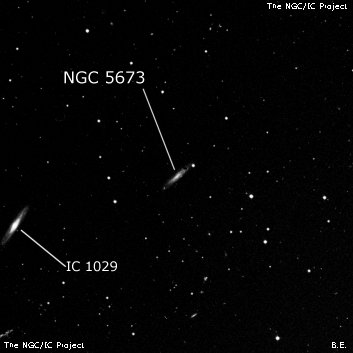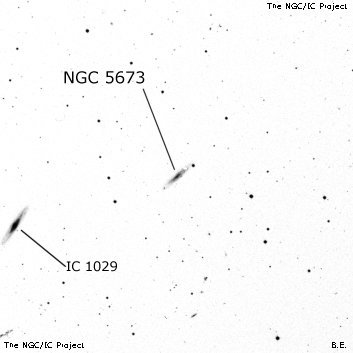NGC/IC Project Restoration Effort
(This is a very very beta version)
NGC5673


Basic Information
Location and Magnitude
Right Ascension: 14:31:30.6
Declination: +49:57:31
Constellation: BOO
Visual Magnitude: 12.1
Historic Information
Discoverer: Herschel W.
Year of discovery: 1787
Discovery aperture: 18.7
Observational
Summary description: F, S, cE, * 15 np
Sub-type: SBc
Corwin's Notes
=====
NGC 5673 and IC 1029. It's clear that -- in spite of Dreyer's note (in his
1912 edition of William Herschel's papers) to the contrary (he was misled by
John Herschel's position for the north-preceding galaxy) -- WH saw the south-
following object of the pair. His position is very good, and his description
"pB, S, E" leaves no doubt that it was the brighter of the two galaxies that
he picked up in his sweep. It is also clear that John Herschel saw the north-
preceding object. Again, his position is good, and his description "vF, pmE,
sf a * 15m" is spot-on for the object.
Faced with the problem of whether to use William or John's position for N5673,
Dreyer simply followed the GC. For this, Sir John adopted his own position,
believing (correctly) that it is statistically more reliable than his
father's. Also believing that there was only one nebula in the field, Sir
John (and Dreyer after him) did exactly what I would have done in the same
situation: place the GC number (to be followed by the NGC number), on the
fainter of the two galaxies.
Bigourdan saw and measured both, though there is a typo in his 8 June 1899
description for NGC 5673: his comparison star is -1 min 48 sec -- not -1 min
58 sec -- away from BD +50 2091. Once this is corrected, his positions
(re-reduced with respect to the Guide Star Catalogue positions for his
comparison stars) agree very well with modern values from Dressel and Condon
(used in RC3), and from the GSC. It's interesting to read his first
description of IC 1029: "... the star near [N5673] mentioned in the GC
description was not seen" (a very free translation by yrs trly). I think that
he must have believed when he observed it that this object, quite the brighter
of the two, was the GC (and NGC) galaxy. His estimates of the magnitude (12
and 12.8) of the star in his descriptions of N5673, by the way, are much more
in line with today's magnitude scale than is Sir John's single estimate of 15.
But we know that the scale was considerably stretched in Sir John's day, and
was not rationalized until Pogson did his work in the mid-1800's.
In any event, we end up with the number NGC 5673 = h1838 on the fainter
galaxy, and the brighter galaxy is IC 1029 = H II 696 = B 185. As I said, I
believe that we should leave things this way. We have, after all, the
authority of the GC, the NGC, and the IC behind the numbering. And I see no
reason to introduce confusion if we don't have to (though I have done it in
other cases).
In addition, if we adopt the other point of view and give Sir William
historical precedence, then the north-preceding galaxy looses its GC and NGC
numbers (though not its number in Sir John's 1833 list) altogether, and the
south-following nebula becomes N5673 = I1029. There is no justification at
all for transfering the number I1029 to the north-preceding object; this
number was given to the south-following nebula by Dreyer, and there is no
confusion of position or nomenclature for it in Bigourdan's observations, or
in the IC.
Steve's Notes
=====
NGC 5673
17.5" (6/24/95): faint, edge-on 5:1 NW-SSE, 2.2'x0.4'. NGC 5673 has similar dimensions and position angle as IC 1029 9.7' ESE but doesn't contain a bright core so is not nearly as prominent in the same field. A mag 13.5 star is at the NW tip 1.1' from center. IC 1029 = UGC 9361 appeared moderately bright, edge-on 5:1 NNW-SSE, 2.0'x0.4'. Contains a very small and round prominent core with a faint stellar nucleus at moments. Located 3.2' W of a mag 9.5 star.



